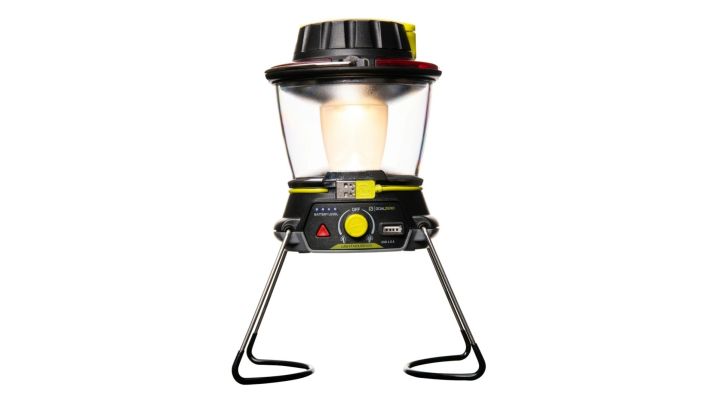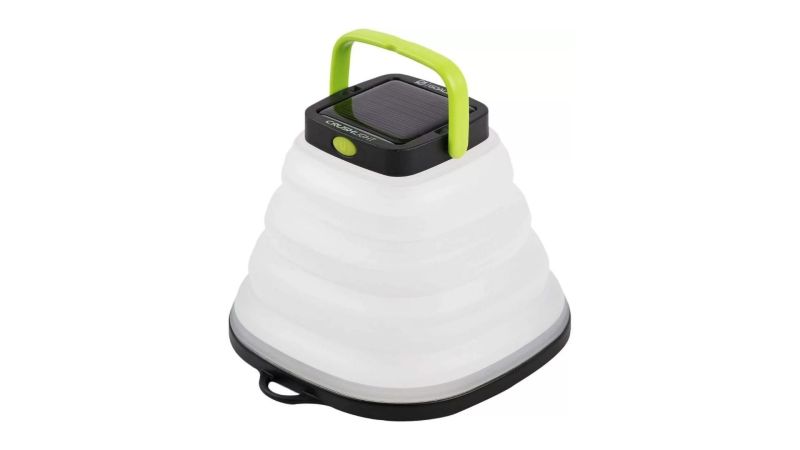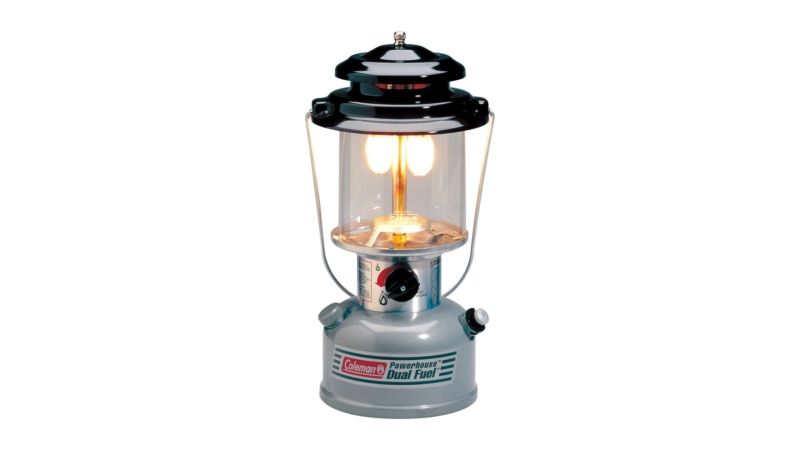We may earn revenue from the products available on this page and participate in affiliate programs.

Camping lanterns are a great way to keep your campsite fired up after dark and make a cabin or tent feel more like home. They also have a pretty badass history that you can regale your friends with every time you use one.
Obviously, we all know about the “one if by land, two if by sea” code and Paul Revere’s midnight ride. Lanterns were also used by members of the underground railroad to mark safe houses. They continued to be used by actual railroads into the 1900s to mark significant points and pass instructions. In fact, the use of colored globes eventually led to the red, yellow, and green traffic lights we use today. See, you didn’t think you’d learn this much from a camping lantern review but here you are — already smarter.
We tracked down some of the best camping lanterns out there to help you cut to the chase. We’ve got recommendations on rechargeable, solar, and gas-powered lanterns so you can find what works best for you. If you need help deciding, there’s enough background information here to get you on the right path.
Best Overall
Goal Zero Lighthouse 600
Best Value
Energizer LED Camping Lantern
Editor’s Choice
BioLite AlpenGlow 500
Best Car Camping Lantern
LuminAID Solar Inflatable Lantern
Best Solar Camping Lantern
Goal Zero Crush Light
Best Gas-Powered Camping Lantern
Coleman Powerhouse Dual Fuel
Best Rechargeable Electric Camping Lantern
Black Diamond Moji
Best Camping String Light
Power Practical Luminoodle
Why you should trust us
We’re big proponents of staying outfitted with the best camping gear possible. That means seeking out quality items and getting the most for your money. The search for awesome equipment has led us to some fantastic camping accessories that can transform your campsite from primitive to cutting-edge. When it comes to lighting up the dark, we’ve reviewed enough LED flashlights, rechargeable flashlights, and headlamps to know what works and what doesn’t. As always, we want to make sure you have access to reliable gear regardless of your budget. Whether you want to power your camping lantern with electricity or gas, we have you covered.
Types of camping lanterns
Camping can take a lot of different forms, so it stands to reason that camping lanterns are just as varied. There are advantages and disadvantages to each. We’re here to make sense of the different power sources, features, and benefits you should consider to narrow down your search for the right one.
Battery
Most of the camping lanterns out there use electricity to generate light. Electricity is cheap (if not free), efficient, and doesn’t produce toxic emissions like traditional fuels. Camping lanterns that use disposable batteries are usually the cheapest, but rechargeable batteries are also available and pay for themselves in the long run.
Rechargeable batteries are tough to beat because they can be charged from a wall or car outlet, power bank, or solar charger. Many can also be used to charge other devices like your phone, GPS, or two-way radio. In most cases, a camping lantern with a rechargeable battery would be our go-to option. That being said, there are times when something else is a better tool for the job.
Solar panels and hand cranks
Even if you know you want an electric camping lantern, there may be times when you don’t have access to a power source or spare batteries. Extended camping trips, long hikes, and emergency situations can stretch disposable and rechargeable batteries to the point of failure. When that happens, you’ll have to generate your own power.
Two power sources you can count on are the sun and your own body. Camping lanterns that are powered by a built-in solar panel or a hand-crank are a fantastic backup for emergency survival situations. They may take more time and effort to keep charged, but they might be the only light source you can count on.
Gas
Gas camping lanterns have been popular for ages. We’ve used them to light our campsites and relied on them during long power outages at home. Gas-powered lanterns can last a very long time and generate tons of light. They’re also great for emergency preparedness because the fuel remains stable for a long time and isn’t reliant on the grid to stay operational.
The downside to fuel-burning lanterns is increased risk. While they’re generally safe, you will need to use caution to prevent nearby objects from overheating and catching fire. Burning petroleum-based fuel also generates carbon monoxide that can be deadly if allowed to get too concentrated. Proper ventilation is critical to the safe operation of any gas lantern.
Key features of camping lanterns
There are three main considerations to keep in mind when shopping for a camping lantern: how much light is produced, how long it will last, and how easy it is to transport. Weigh each of those factors against each other to determine what’s best for your style of camping. No camping lantern is perfect in every situation.
Output
The amount of light a camping lantern produces is measured in lumens. Calculating that number is over our heads, but LED Watcher has a pretty thorough explanation if you’re interested in getting into the weeds. Simply put, the larger the area you’re working with, the more lumens you’ll need to light it adequately.
More isn’t always better when it comes to lanterns, though. Too much light can ruin your night vision and strain your eyes. We appreciate lanterns with variable output and different colors of light. Camping lanterns can range from 10 lumens for reading in bed to 1,000 lumens for cooking and hanging out after dark.
Run-time
Camping lantern run-time varies widely, but most of our picks can be run for 20 to 48 hours. Battery life falls off significantly with higher output, so the best way to stretch the life of an electric lantern is to use a low power setting. The Energizer LED Camping lantern takes the top spot with a claimed 650-hour lifespan under optimal conditions. Plug-in options like the Power Practical Luminoodle have a limitless run-time, but require an external power source.
Gas-burning lanterns have a relatively limited run-time compared to efficient electric alternatives. The Coleman Powerhouse Dual Fuel can burn for up to 20 hours on a single tank. On the flip side, they can be refueled in seconds rather than being plugged into a power source for several hours.
Portability
Part of the appeal of camping lanterns is their portability and compact size. The largest lanterns on this list are easy to toss in a car or camper. Compact alternatives can slip into a pack or even be attached to the outside during a long hike to keep your load light.
Power sources also play a role in determining a lantern’s portability. Gas bottles and batteries can go anywhere you carry them, so you don’t have to rely on a vehicle, generator, or power grid to have light. Both are efficient, but electricity that can be recharged manually or with a solar bank has the ultimate long-term edge over flammable fuel or disposable batteries.
Benefits of camping lanterns
Hands-free light
You’ve got better things to do than hold a flashlight when you’re camping. A good camping lantern is a game-changer when it comes to setting up camp and cooking after dark because you can set one up and light up the whole campsite. Lanterns are a big advantage in areas where campfires aren’t allowed — remember to check the rules regarding open flames where you camp if you plan on using a gas-powered lantern.
Camping lanterns are also great inside a tent, where they can be hung from the peak to act as a wilderness-ready ceiling light. Everyday activities like cooking, cleaning up, changing clothes, and playing campsite games are a lot easier when you have a well-lit area.
Area illumination
Flashlights and headlamps are great for a lot of things (and we definitely recommend having several options handy), but lanterns that cast a 360-degree glow do a better job of making a campsite feel more like home.
Before you buy a camping lantern, consider how much space you want to light. If you’re just concerned about a tent or a vehicle, something small like the LuminAID lantern is great. If you want to light an entire campsite, a more powerful option like the Goal Zero Lighthouse 600 is a better choice. All our picks are solid options to have on hand in the case of an emergency or power outage because they can be just as effective in your home.
Wide selection of power sources
One of the biggest advantages when shopping for a camping lantern is having your choice of power sources. Disposable batteries are readily available and last several years in storage, making them a great backup to have in your emergency kit or go bag. Rechargeable batteries can keep you powered on the go and some can charge your other devices, too. Solar and hand-crank electric lanterns are totally self-sufficient and are perfect for long camping trips or disaster preparedness.
Traditional fuels can also be used to power some lanterns. Our favorite, the Coleman Powerhouse Dual Fuel can run off white gas or gasoline, making it an efficient and versatile off-grid option. Just remember to pack enough fuel for your entire trip.
Camping lanterns pricing
Budget
If you only have $25 to spend, there are a surprising number of camping lanterns available to you. Most of them are fine for casual use but aren’t robust enough for us to recommend for use on the trail or in an emergency. There are a few good ones, though, like the Energizer LED Camping Lantern that earned our pick for best value and the LuminAID lantern that we recommend for car camping.
Don’t expect excellent materials and a long list of features at this price. That being said, an inexpensive light might be just what you need and you shouldn’t have to go without just because your money is needed elsewhere.
Mid-range
For some reason, the middle of the camping lantern market isn’t as fruitful as we expected. It seems like there are lots of affordable options and lots of premium options, but fewer in the middle ($25 to $50) that we get excited about. This is a pretty safe range to shop, though, so you should have plenty to choose from even if a given lantern didn’t stand out from the crowd enough to earn a spot on our list.
Some that we do like are the Goal Zero Lighthouse 600 and Power Practical Luminoodle. These lanterns have useful features and a high level of build quality. They’re very different from one another, but we’d be happy to have either one at our campsite.
Premium
Beyond the $50 mark, the camping lantern market starts to get very compelling. This price range is where you’ll find high-end offerings from Goal Zero, BioLite, Black Diamond, and Coleman. Rechargeable batteries take over for disposable ones, and you’ll have the option to switch to liquid fuel if you prefer.
The cost of these lanterns means you’ll have to spend more nights outdoors to justify the added expense, but we think the build quality and features are worth it. Power other devices off your lantern, generate power manually to go totally off-grid, or switch between white gas and gasoline in a pinch. The choice is yours.
How we chose our top picks
To make this gear guide as strong as possible, we sought out camping lanterns that work in a wide range of environments. Want something for your trailer camper? No problem. Need a sustainable light source for your hiking adventure or go bag? We have you covered. Only reliable products with a proven record of success made the cut. To account for everyone’s needs, we chased down the best options for car camping, backpacking, and emergency use. We included options that run on disposable and rechargeable batteries, solar power, manual power, and traditional fuels like white gas, kerosene, and gasoline. Of course, we also care about finding products that suit different budgets. We’ve got lanterns here ranging from $10 to $100.
FAQs on camping lanterns
You’ve got questions, Task & Purpose has answers.
Q. How many lumens do I need for a camping lantern?
A. Lanterns generally produce less light than a traditional flashlight. They’re designed to light up the surrounding area, not shine hundreds of yards through the darkness.
Q. How bright are camping lanterns?
A. We found some camping lanterns that approach 1,000 lumens, but most produce closer to 500. Smaller lanterns generate less light than that with the tradeoff of being lighter, more portable, and less expensive.
Q. Are propane lanterns safe?
A. Propane lanterns are generally safe, but you should use extra caution anytime you’re working with an open flame. Keep flammable objects away from your propane lantern and make sure you have adequate ventilation to avoid carbon monoxide poisoning.
Q. How long does a lantern light last?
A. A run time of 20 to 48 hours is a safe bet for most camping lanterns. The Energizer LED Camping Light is the longest-lasting on this list, with a claimed maximum run time of 650 hours on the low setting, but that’s an outlier.
Our gear section
Scott Murdock is a Task & Purpose commerce writer and Marine Corps veteran. He’s selflessly committed himself to experiencing the best gear, gadgets, stories, and alcoholic beverages in the service of you, the reader.










